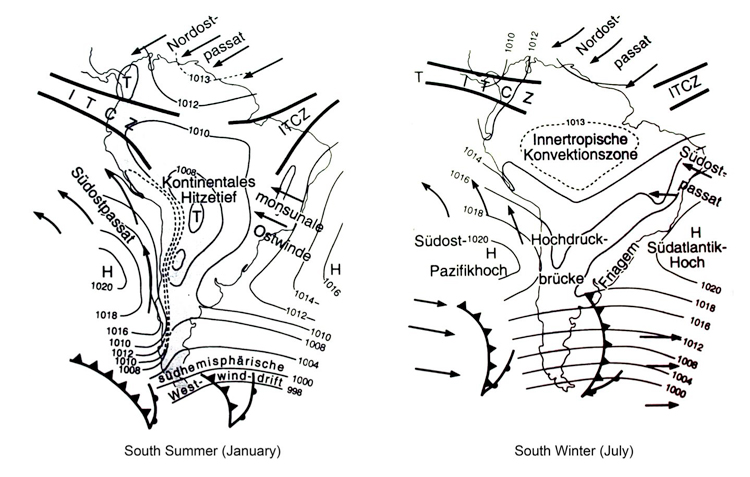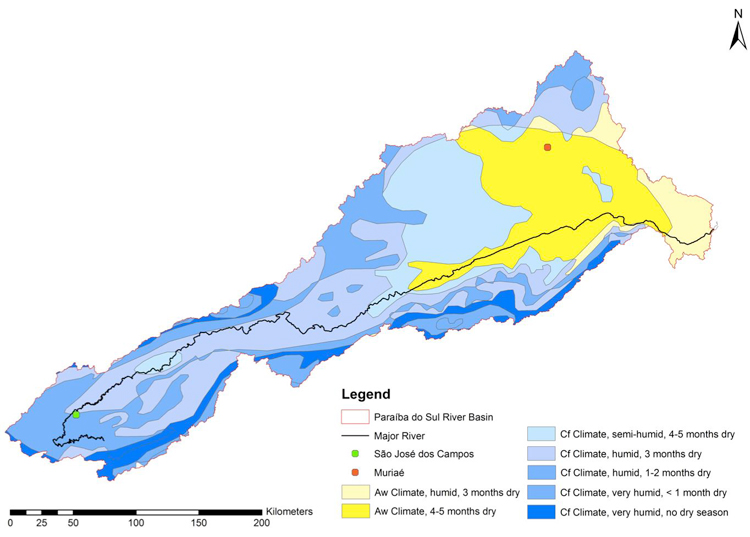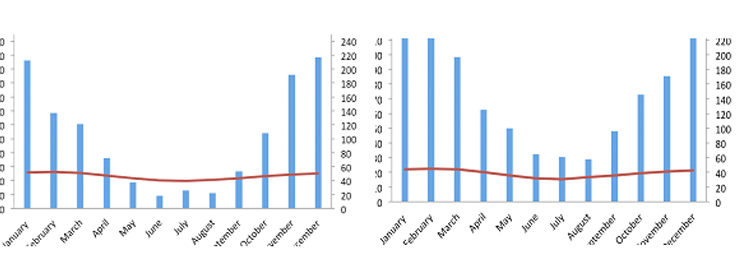PARAÍBA DO SUL (BRAZIL)
Climate
CLIMATE CLASSIFICATION
The southeast region of Brazil is characterized by climatic diversity. According to the latest Köppen-Geiger climate classification, the PDS is characterized by tropical as well as mesothermal climates (Kottek et al., 2006). The average temperature differences between day and night are larger than the temperature differences between the individual months (diurnal climate). The movement of the Innertropical Convergence Zone (ITCZ) causes seasonal differences over the year. In winter (June to September) the movement of the ITCZ provokes the presence of the South Atlantic Anticyclone causing dry conditions with an average rainfall below 60 mm per month (Weischet & Endlicher, 2008). The summer (November to January) is characterized by a pronounced rainy season due to the influence of the trade winds blowing from southeast.

Two predominant climates can be identified in the PDS. In the lower part of the basin, a tropical wet and dry climate (Aw) with a pronounced dry season of 3 to 5 months and a monthly mean temperature above 18° Celsius is prevalent (IBGE, 2014). The average annual rainfall of around 1200 mm is lower than in other parts of the basin (Ovalle et al., 2013). Exemplarily, a climate diagram of the city of Muriaé is provided in the following figure.

Along the middle and upper part a Moist Continental Climate (Cf) is dominating (IBGE, 2014). It is characterized by significant rainfall throughout the year and a shortened dry season of 1 to 3 months at altitudes up to 800 metres. There is no dry season within the grant mountain ranges, where the annual rainfall with around 2000 mm, is the highest throughout the basin (Ovalle et al., 2013). The city of São José dos Campos, located upstream in the state of São Paulo is characterized by such climate. Locations in direct proximity to the foot of the mountain ranges, such as Petrópolis, are also missing a dry season due to orographic rain (Almeida et al., 2013).

References and further reading:
Almeida, J. R., Silva, C. E., Rodrigues, M. G. (2013) Evaluation of the environmental impacts caused by deforestation in the hydric regimen of the metropolitan region of Petrópolis (RJ), Brazil, Engineering Sciences, Aquidabã, 1(1), 14‐21.
Endlicher, W. (2005) Luftdruck- und Windverhältnisse im Südsommer und -winter. Ein Entwurf. Offizielles Vorlesungsskript - Regionale Geogrpahie Südamerikas. Ländliche Struktur und Individualität eines Kontinents.
IBGE (2014) Instituto Brasileiro de Geografia e Estatística, http://www.ibge.gov.br/home/geociencias/default_prod.shtm, accessed: 01.11.2014.
Kottek, M., Grieser, J., Beck, C., Rudolf, B., Rubel, F. (2006) World Map of the Köppen-Geiger climate classification updated, Meteorol. Z., 15, 259-263. DOI: 10.1127/0941-2948/2006/0130.
Ovalle, A.R.C. et al. (2013) Long-term trends in hydrochemistry in the Paraíba do Sul River, southeastern Brazil, Journal of Hydrology 481, 191-203.
Weischet, W., Endlicher, W. (2008) Einführung in die Allgemeine Klimatologie, 7. Auflage, Gebr. Bonrtraeger Verlagsbuchhandlung. Berlin, Stuttgart.

